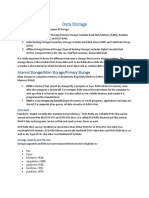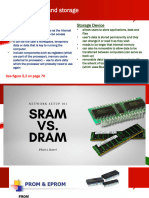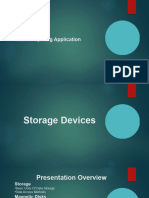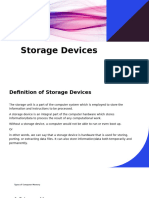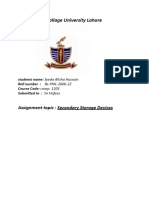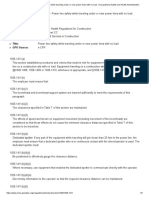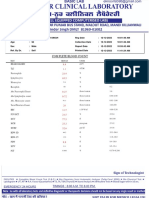0 ratings0% found this document useful (0 votes)
11 viewsCSS - Lesson 5
Uploaded by
Catherine BotardoCopyright
© © All Rights Reserved
Available Formats
Download as PPTX, PDF, TXT or read online on Scribd
0 ratings0% found this document useful (0 votes)
11 viewsCSS - Lesson 5
Uploaded by
Catherine BotardoCopyright
© © All Rights Reserved
Available Formats
Download as PPTX, PDF, TXT or read online on Scribd
You are on page 1/ 22
Lesson 1
Lesson 5: Multimedia Storage
Devices
E X PE CTATI O N
• At the end of this module, student will be
able to:
• 1. identify the different multimedia storage
devices;
• 2. understand functions, advantages &
disadvantages of the different multimedia
storage devices;
• 3. appreciate the importance of learning
the different multimedia storage devices.
LESSON
MULTIMEDIA STORAGE DEVICES
The storage devices are one of the most
important components of the computer system.
They are the data storage devices that are used
to store the data. The computer has many types
of data storage devices. Some of them can be
classified as the Internal Storage Devices and
External Storage Devices.
INTERNAL STORAGE DEVICES
Internal storage device/s are devices that
are installed or prebuilt in a computer system.
These devices vary in types and storage
capacities. The following are examples of
Internal Storage Devices.
1. Hard Disk Drive (HDD)
This is the computer's main
storage
device used to store all data on
the computer permanently using
magnetic
storage disk.
There are two types of HDD
according to its connector:
a. SATA (Serial ATA)
b. EIDE (Enhanced Integrated
Drive
Electronics)
Advantages of Hard Disk Drives:
a. Capable of holding vast amounts of data at
affordable prices
b. Fast read and write speeds
c. Reliable technology
d. Relatively small in size
Disadvantages of Hard Disk Drives:
a. Due to the nature of its moving parts, they will
eventually wear and break
b. Although very fast, waiting for the moving parts
means it will never perform as fast as solid state
drives
c. More fragile and less robust than a solid state
drive
d. Higher power consumption than a SSD
e. Some noise is created by the moving parts
2. Hybrid Hard Drive (HHD)
HHD or Hybrid Hard
Drive is a combination of
Hard Disk Drive and Solid
State Drive technology.
They’re bigger than
Solid State Drive (SSD)
and
faster than a plain-old
mechanical drive.
3. Solid State Drive (SSD)
Non-volatile storage
devices capable of
holding large amounts of
data.
Perform faster than
traditional hard disk
drives, however they are
significantly more
expensive.
Advantages of solid state drives:
a. Extremely fast read/write speeds
b. Small in physical size and very light, ideal for
portable devices
c. No moving parts to wear, fail or get
damaged – ideal for making portable computers
and devices more reliable and durable
d. Uses less power than a HDD, increasing
battery life time
e. Very quiet
f. Generates less heat
Disadvantages of Solid State Drive:
a. Expensive
b. Limited in capacity due to the expense
EXTERNAL STORAGE DEVICES
External storage devices, also referred to
as auxiliary storage and secondary storage, are
devices that contain all the addressable data
storage that is not inside a computer's main
storage or memory. Basically, external storage
devices are removable & portable. The
following are examples of External Storage
Devices.
1. External Hard Drive
Also known as a portable hard drive, is a
device that is connected outside of a
computer system.
Portable storage device that usually uses
ATA, USB technology or E-SATA technology.
2. USB Flash Drive
Also known as data stick, pen drive,
keychain drive and thumb drive.
It is a data storage device that includes
flash memory with an integrated USB
interface and typically removable, rewritable
and much smaller than an optical disc.
Advantages of USB Flash Drive:
a. Portable - small and lightweight
b. Durability - flash has no moving parts to damage
c. Range of capacities available
d. Fast speeds, with no moving parts of boot up
time
Disadvantages of USB Flash Drive:
a. Limited number of write cycles possible
b. Limited storage capacities
c. Expensive storage option compared to a HDD
3. Compact Disk (CD)
It is a flat, round storage device that can be
read by a laser in an Optical Disc Drive and
capable of storing data up to 700 MB.
Applicable for Audio, Video and small amounts
of data
Types of Compact Disc:
a. CD-ROM (Read Only) - the data is
permanently written to the disc at the
point of manufacture.
b. CD-R (Recordable) - blank discs that
can be burnt (written to) once.
c. CD-RW (Re-writable)- - blank discs
that can be burnt (written to) over and
over again (can be erased and reused
many times).
4. Digital Versatile Disc
A disc capable of storing large amounts of
data up to 4.7 GB compared to compact
disc.
Data can be stored and retrieved using
Optical Disc Drive
Applicable for standard definition movies
and data
Types of Digital Versatile Disc:
a. DVD-ROM (Read Only) - the data is
permanently written to the disc at the point of
manufacture.
b. DVD-R (Recordable)- blank discs that can
be burnt (written to) once.
c. DVD-RW (Re-writable)- blank discs that can
be burnt (written to) over and over again (can
be erased and reused many times).
5. Blu Ray Disc
An optical disc capable of storing data from
25 GB up to 128 GB
The name "Blu-ray" refers to the blue laser
(which is actually a violet laser) used to write
and read the disc
Applicable for HD videos and large
amounts of data
Types of Blu Ray Disc:
a. Blu-Ray-ROM (Read Only) - the data is
permanently written to the disc at the point of
manufacture.
b. BD-R (Recordable)- blank discs that can be
burnt (written to) once.
c. BD-RE (Re-writable) - blank discs that can
be burnt (written to) over and over again (can
be erased and reused many times).
• Activity # 5: COMPLETE THE TABLE
• Direction: Complete the table below by listing the Internal
and External Storage Devices.
You might also like
- Igcse Ict Storage Devices and Media 0417No ratings yetIgcse Ict Storage Devices and Media 04173 pages
- Data Storage: Internal Storage/Main Storage/Primary StorageNo ratings yetData Storage: Internal Storage/Main Storage/Primary Storage7 pages
- Computers - Storage & Memory Devices: Chapter-1No ratings yetComputers - Storage & Memory Devices: Chapter-130 pages
- Storage Devices: Mohit Kumar Pandey Mohit NeheteNo ratings yetStorage Devices: Mohit Kumar Pandey Mohit Nehete31 pages
- Storage Devices Are Any Type of Hardware That Is Capable of Storing andNo ratings yetStorage Devices Are Any Type of Hardware That Is Capable of Storing and2 pages
- Secondary Storage in Operating Systems.No ratings yetSecondary Storage in Operating Systems.24 pages
- request-letter-new-assessment-February-20-2025-CSS-CATO-NATIONALNo ratings yetrequest-letter-new-assessment-February-20-2025-CSS-CATO-NATIONAL2 pages
- request-letter-new-assessment-February-18-2025-CSS-CATO-NATIONALNo ratings yetrequest-letter-new-assessment-February-18-2025-CSS-CATO-NATIONAL2 pages
- Me-0-Tablazon-Jasmine Nicole_20241129_061130_0000 (1)No ratings yetMe-0-Tablazon-Jasmine Nicole_20241129_061130_0000 (1)15 pages
- Introduction Computer Systems Servicing NC II 191104201741No ratings yetIntroduction Computer Systems Servicing NC II 19110420174117 pages
- Quarter I Summative Assessment #1: Computer System Servicing Grade 12 S.Y. 2021-2022No ratings yetQuarter I Summative Assessment #1: Computer System Servicing Grade 12 S.Y. 2021-20221 page
- Demonstration Lesson Plan in CSS-11 Lan Cabling100% (3)Demonstration Lesson Plan in CSS-11 Lan Cabling5 pages
- Questions 21 To 41, Choose The Appropriate Option To Complete The DialoguesNo ratings yetQuestions 21 To 41, Choose The Appropriate Option To Complete The Dialogues7 pages
- 1926.1411 - Power Line Safety-While Traveling Under or Near Power Lines With No Load. - Occupational Safety and Health AdministrationNo ratings yet1926.1411 - Power Line Safety-While Traveling Under or Near Power Lines With No Load. - Occupational Safety and Health Administration3 pages
- Homm3 the Shadow of Death Manual - EnglezaNo ratings yetHomm3 the Shadow of Death Manual - Engleza36 pages
- Multiple-Choice Questions On Pressure in Fluids100% (3)Multiple-Choice Questions On Pressure in Fluids3 pages
- Formulation and Solution of Elasticity Problems: Chapter-5No ratings yetFormulation and Solution of Elasticity Problems: Chapter-529 pages
- Quiz. The Pleasure Theory The Utilitarians Zge 1103 EthicsNo ratings yetQuiz. The Pleasure Theory The Utilitarians Zge 1103 Ethics17 pages
- Piping Test Packages Reinstatement StatusNo ratings yetPiping Test Packages Reinstatement Status6 pages
- Figure 1. Probability Density Function For A Normal Random VariableNo ratings yetFigure 1. Probability Density Function For A Normal Random Variable10 pages
- Seasonal Foods: Tota L Hea LTH Acceler AtorNo ratings yetSeasonal Foods: Tota L Hea LTH Acceler Ator3 pages
- Data Storage: Internal Storage/Main Storage/Primary StorageData Storage: Internal Storage/Main Storage/Primary Storage
- Storage Devices Are Any Type of Hardware That Is Capable of Storing andStorage Devices Are Any Type of Hardware That Is Capable of Storing and
- Beginner's Guide for Cybercrime InvestigatorsFrom EverandBeginner's Guide for Cybercrime Investigators
- request-letter-new-assessment-February-20-2025-CSS-CATO-NATIONALrequest-letter-new-assessment-February-20-2025-CSS-CATO-NATIONAL
- request-letter-new-assessment-February-18-2025-CSS-CATO-NATIONALrequest-letter-new-assessment-February-18-2025-CSS-CATO-NATIONAL
- Me-0-Tablazon-Jasmine Nicole_20241129_061130_0000 (1)Me-0-Tablazon-Jasmine Nicole_20241129_061130_0000 (1)
- Introduction Computer Systems Servicing NC II 191104201741Introduction Computer Systems Servicing NC II 191104201741
- Quarter I Summative Assessment #1: Computer System Servicing Grade 12 S.Y. 2021-2022Quarter I Summative Assessment #1: Computer System Servicing Grade 12 S.Y. 2021-2022
- Questions 21 To 41, Choose The Appropriate Option To Complete The DialoguesQuestions 21 To 41, Choose The Appropriate Option To Complete The Dialogues
- 1926.1411 - Power Line Safety-While Traveling Under or Near Power Lines With No Load. - Occupational Safety and Health Administration1926.1411 - Power Line Safety-While Traveling Under or Near Power Lines With No Load. - Occupational Safety and Health Administration
- Formulation and Solution of Elasticity Problems: Chapter-5Formulation and Solution of Elasticity Problems: Chapter-5
- Quiz. The Pleasure Theory The Utilitarians Zge 1103 EthicsQuiz. The Pleasure Theory The Utilitarians Zge 1103 Ethics
- Figure 1. Probability Density Function For A Normal Random VariableFigure 1. Probability Density Function For A Normal Random Variable






















